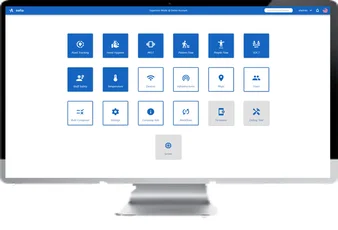Managing capacity ensures your resources align with your business needs, avoiding underutilization and overwork. This article will cover key strategies and benefits of capacity management, practical tools, and real-world examples for better resource allocation.
Key Takeaways
- Capacity management is essential for aligning resource availability with business demand, preventing both overutilization and underutilization of resources.
- Effective capacity management leads to enhanced resource utilization, improved project timelines, and increased employee satisfaction, allowing organizations to adapt rapidly to market changes.
- Implementing structured approaches and utilizing modern tools for capacity management can help organizations optimize operational efficiency and achieve strategic goals.
Understanding Capacity Management

Capacity management is akin to steering a ship through turbulent waters. It’s a structured approach involving three main steps: measuring resource needs, analyzing usage, and tracking progress to ensure smooth sailing. Understanding capacity management is vital for addressing challenges and improving overall management plans, allowing organizations to thrive in dynamic markets.
A proper capacity management process aims to ensure accurate data entry. It also focuses on enhancing overall organizational efficiency. But what exactly does capacity management entail? Let’s delve into its definition and key objectives to get a clearer picture.
Definition of Capacity Management
Capacity management refers to a project management and resource allocation technique aimed at ensuring that a business’s output capabilities align with its resource availability. In essence, it ensures resources are as productive as possible, delivering work on time while avoiding burnout. This involves not just managing physical resources but also human resources, ensuring staff have the necessary skills and availability to meet project demands.
At its core, capacity management encompasses the total sum of resources needed to meet calculated demand levels, aligning strategic goals with actual resource capabilities. The end goal is to have the right capacity at the right time to meet demand, avoiding both over- and under-utilization of resources.
Key Objectives of Capacity Management
The primary objectives of capacity management revolve around maximizing productivity and profit by utilizing resources effectively. Proper capacity management ensures that organizations are ready to meet upcoming project demands without overstaffing, maintaining a delicate balance between available resources and business needs.
Implementing capacity management best practices allows organizations to achieve more straightforward and effective capacity management, significantly impacting overall productivity. Key performance indicators for capacity management include capacity utilization, throughput, cycle time, and work in progress, all of which help measure and enhance performance.
Focusing on these objectives ensures businesses have the right resources available at the right times, leading to smoother operations, better project outcomes, and a more competitive edge in the market.
Benefits of Effective Capacity Management

Effective capacity management offers numerous benefits. These advantages are diverse and significant. It’s essential for preventing resource wastage and optimizing business operations, allowing companies to adapt swiftly to market demands. This adaptability is crucial in maintaining efficiency and staying competitive.
Many companies across various industries apply capacity management practices to better utilize their resources and improve overall efficiency. This approach not only enhances productivity but also improves project timelines and increases employee satisfaction. Let’s explore these benefits in more detail.
Enhanced Resource Utilization
One of the primary benefits of effective capacity management is improved resource utilization. Anticipating needs and ensuring adequate resources are available allows businesses to maximize production output and meet demand efficiently. This involves implementing a solid capacity planning system that significantly reduces resource underutilization, leading to better overall performance.
Utilization rates, calculated by comparing billable hours to total hours worked, provide insights into workforce efficiency. Healthy utilization targets should account for internal meetings, non-project work, context-switching time, and realistic project numbers, ensuring resources are used optimally without overburdening employees.
Improved Project Timelines
Effective capacity management is instrumental in meeting project deadlines by optimizing resource allocation and availability. Ensuring resources are available when needed helps organizations reduce delays and enhance project timelines. This coordination facilitates seamless operations from project initiation to completion, making it easier to manage projects efficiently. Efficient capacity management is crucial for achieving these goals.
Inaccuracies in forecasting can lead to insufficient resources during peak demand periods, compromising project timelines. Effective forecasting of future resource demands allows companies to better prepare for project workloads and allocate staff accordingly, ensuring smoother project execution.
Increased Employee Satisfaction
Proper capacity management fosters a balanced workload among employees, preventing burnout and enhancing job satisfaction. When workloads are evenly distributed, employees are less likely to experience the stress and exhaustion that can lead to significant morale issues, disengagement, and even turnover. By maintaining a balanced workload, organizations can create a more positive and productive work environment.
Capacity planning aids in managing employee expectations, helping to maintain morale and retention rates. It ensures that employees are not overwhelmed with too many tasks at once, allowing them to perform their duties more effectively and with greater satisfaction.
Common Challenges in Capacity Management

Despite its benefits, capacity management comes with its own set of challenges. Common issues include misalignment between teams, inaccurate forecasting, and problems with resource utilization. These challenges can significantly impact a company’s ability to meet project deadlines and maintain operational efficiency.
Every fourth manager identifies capacity as a major challenge, highlighting the significance of effective management approaches. Let’s delve into specific challenges to understand their impact better and explore how to address them.
Misalignment Between Teams
Misalignment between sales and delivery teams can lead to project delays and dissatisfied clients. Differences in priorities between these teams create significant capacity management challenges, as each group may have conflicting goals and timelines. This misalignment disrupts project flow and resource allocation, necessitating better communication and coordination.
Inaccurate Forecasting
Accurate scheduling is essential for effective resource capacity planning, as incorrect forecasts can lead to resource shortages at crucial project phases. Inaccurate forecasts hinder the identification of resource conflicts, limiting the ability to adjust schedules to avoid issues. Decisions regarding resource allocation often depend on accurate forecasts, affecting whether projects are prioritized or additional resources are needed.
Forecasting inaccuracies in capacity management can stem from insufficient real-time data, leading managers to rely on guesswork rather than informed decisions. Predictive workforce analytics can help businesses better anticipate future capacity needs by analyzing historical employee data.
The absence of effective monitoring tools can lead to distorted perceptions of workload distribution, complicating accurate forecasting in capacity management.
Overutilization and Underutilization
Overburdening employees can lower job satisfaction and negatively affect their health, while underutilization can lead to wasted resources and decreased productivity. Effective capacity management increases client satisfaction by delivering quality work on time and avoiding delivery issues due to a lack of available resources.
Balancing resource allocation is crucial to prevent both over- and underutilization, ensuring optimal performance and employee well-being.
Key Capacity Management Strategies
Businesses can adopt various strategies to navigate the complexities of capacity management. These strategies involve systematic approaches that help effectively manage resources concerning demand. Implementing capacity management allows businesses to proactively respond to market changes, optimizing resource utilization and maintaining efficiency.
Manufacturing firms, for instance, often implement capacity management strategies to address variability in consumer demand, ensuring efficient production schedules. Let’s explore four key strategies: lead, lag, match, and adjustment.
Lead Strategy
The lead strategy allows businesses to prepare for future demands by maintaining extra capacity. This excess capacity ensures that businesses can quickly respond to increased demand without delays.
However, it requires careful planning to avoid unnecessary costs and resources.
Lag Strategy
The lag strategy involves adding resources only when current capacity is maxed out, aligning resource availability with actual demand, and preventing overcapacity until necessary. While it helps control costs, the risks include potential overspending on underused resources and employee burnout due to stretched capacities.
Match Strategy
The match strategy in capacity management balances current resources with future capacity needs. Its primary objective is to adjust available resources to reflect current and near-future demands, requiring advanced resource calculation and planning capabilities, all within a capacity management strategy.
However, it can be resource-intensive and reliant on assumptions, posing challenges for long-term planning.
Adjustment Strategy
The adjustment strategy involves adding or reducing capacity based on client demand or significant changes, allowing for real-time responsiveness to client demands or major business shifts. For example, a TV manufacturer might lease machines or hire contractors temporarily to handle fluctuating demand, demonstrating the importance of flexible capacity planning.
Tools and Software for Capacity Management

In today’s digital age, tools and software play a crucial role in effective capacity management. Capacity management software is designed to automate capacity management plans, providing accurate insights into capacity and demand gaps. Utilizing a centralized capacity management tool helps optimize resource allocation and project delivery, enhancing operational efficiency.
AiRISTA’s solutions, for instance, offer predictive analytics and Real-Time Location Systems (RTLS) to improve decision-making in hospital capacity management, ensuring better patient outcomes and operational efficiency.
Let’s explore essential features and recommended tools for capacity management.
Capacity Management Software Features
Effective capacity management tools must feature comprehensive reporting and forecasting capabilities to enhance decision-making. Tools like Runn provide centralized dashboards that generate reports on utilization and track KPIs, aiding in resource management. ActivTrak offers dashboards and in-depth analytics for both historical and real-time data, facilitating better insights into workforce productivity. Having an accurate view of team capacity ensures that projects align with available resources effectively.
Steps to Improve Capacity Management
Improving capacity management involves a series of strategic steps designed to enhance resource utilization and operational efficiency. These steps include measuring current capacity, analyzing and planning for future demands, and effectively managing capacity by implementing best practices. Following these steps ensures businesses are well-prepared to meet both current and future demands.
Let’s delve into each of these steps to understand how they contribute to more effective capacity management and ultimately, to the success of your organization.
Measure Current Capacity
The first step in improving capacity management is to measure current capacity levels. This involves evaluating financial, human, and IT resources to get a comprehensive view of resource availability. Analyzing historical data can reveal patterns related to past capacity management issues, helping to identify potential bottlenecks and areas for improvement.
Teams can calculate their current resource capacity using historical time data from time logs, providing a realistic picture of their capabilities. This assessment helps in identifying underutilized resources, allowing for better allocation and improved efficiency.
Let’s look at hospital admissions. According to the IHI, reducing ED boarding to under 6 hours reduced in-hospital mortality from 17.4% to 12.9% and reduced the length of stay. But first, you must be able to measure wait times. Hospitals that provide an RTLS-enabled patient tag can not only monitor patient wait times and alert them to excessive waits, but they can also track the patient’s location and deliver a message when it’s their turn. Capio St. Göran Hospital in Stockholm Sweden uses AiRISTA’s B4n messaging tag to manage patients waiting for surgery. The result was reduced delays, improved patient throughput, and increased patient satisfaction.
Analyze and Plan for Future Demands
Once current capacity is measured, the next step is to analyze and plan for future demands. Methods such as forecasting, market research, and customer surveys are used to project needed resources. Historical data plays a crucial role in this process, providing insights into trends for workforce capacity planning and helping to identify predictable seasonality in project demands.
Consulting sales departments about upcoming projects can greatly enhance resource forecasting accuracy, ensuring resources are allocated effectively. A technology firm, for example, utilized predictive analytics to forecast demand, enabling effective resource allocation during peak periods.
Implement Best Practices
Implementing best practices involves establishing a structured approach to capacity management, which includes measuring needs, analyzing usage, and tracking progress. Many leaders mistakenly rely on instinct rather than data for capacity planning, leading to potential miscalculations. A well-structured capacity planning process minimizes both resource oversupply and undersupply, enhancing overall productivity.
Monitoring and Adjusting Capacity Management Plans
Capacity management is an ongoing process that requires continuous monitoring and adjustment. Regular assessments ensure that capacity management plans align with changing market conditions and organizational needs. Effective capacity management ensures resources are efficiently allocated across projects, helping organizations avoid resource bottlenecks.
Different capacity management approaches, such as the match strategy, offer flexibility by enabling organizations to increase resources as needed based on current demands. Let’s explore how regular reviews and adaptability contribute to effective capacity management.
Regular Capacity Reviews
Regular capacity assessments are essential to align resources with ongoing project needs and avoid unnecessary financial expenditures. Scheduled evaluations help identify areas needing improvement and ensure capacity management practices remain cost-effective.
Recurring tweaks are a requirement for capacity management planning, ensuring that strategies are always aligned with actual business demand.
Adapting to Changes
Flexibility in capacity management is crucial to meet unforeseen changes in demand and effectively utilize resources. Regularly monitoring capacity management plans ensures they align with actual business demand and market trends, allowing businesses to remain competitive.
Adapting to changes in client demand is essential, and an adjustment strategy can help organizations respond dynamically to these shifts. Scheduling regular capacity reviews helps assess the effectiveness of capacity management strategies and make necessary adjustments, ensuring continuous operational efficiency.
Capacity Management Metrics
Metrics are vital for assessing the performance of capacity management. Key metrics include utilization rates, performance metrics, and efficiency rates, which help evaluate and enhance organizational performance. These metrics provide insights into how well resources are utilized and identify areas for improvement.
Throughput, for example, measures the speed at which products or services are delivered, serving as a critical performance metric in capacity management. Let’s delve into specific metrics to understand their importance in effective capacity management.
Utilization Rates
Utilization rates are calculated by dividing actual output by potential output and expressing it as a percentage. For instance, the weekly capacity for 50 employees each working 40 hours is 2,000 hours. Monitoring these rates provides insights into workforce efficiency and helps identify underutilized resources.
A manufacturing company, for example, improved its overall equipment effectiveness by 25% after adopting a comprehensive capacity monitoring system. This highlights the importance of tracking utilization rates to enhance production efficiency and optimize resource allocation.
Performance Metrics
Performance management in capacity management shows the speed at which a system can handle requests. It indicates how quickly the system can respond to user needs. To optimize productivity, it’s essential to measure resource needs, analyze their usage, and track progress. Productivity metrics can include output per labor hour or total output relative to input, providing a clear picture of resource efficiency.
By monitoring these metrics, businesses can make informed decisions to enhance business capacity management practices, ensuring they monitor actual business demand and maintain operational efficiency.
Why Capacity Management is Important
Effective capacity management is essential for optimizing resources, meeting project deadlines, and enhancing employee satisfaction. By understanding and implementing key capacity management strategies, businesses can navigate common challenges and ensure they have the right resources available at the right times.
Capacity management tools and software play a crucial role in this process, providing the necessary insights and automation to streamline resource allocation and project planning. By continuously monitoring and adjusting capacity management plans, businesses can adapt to changing demands and maintain operational efficiency. Embrace these strategies and tools to elevate your capacity management practices and drive your business toward success.
Frequently Asked Questions
What is capacity management?
Capacity management is a crucial technique that ensures a business’s output aligns with its available resources, optimizing efficiency and productivity. Effective capacity management leads to better resource allocation and improved project outcomes.
What are the key objectives of capacity management?
The key objectives of capacity management are to maximize productivity and profit through effective resource utilization, ensure readiness to meet project demands, and maintain a balance between available resources and business needs.
What are some common challenges in capacity management?
Common challenges in capacity management include misalignment between teams, inaccurate forecasting, and issues with resource utilization, which ultimately affect project deadlines and operational efficiency. Addressing these challenges is crucial for enhancing organizational performance.
What are the benefits of effective capacity management?
Effective capacity management leads to enhanced resource utilization, improved project timelines, and increased employee satisfaction, ultimately driving better overall business performance.





